The Côte de Nuits is a French wine region located in the northern part of the Côte d'Or, the limestone ridge that is at the heart of the Burgundy wine region. It extends from Dijon to just south of Nuits-Saint-Georges, which gives its name to the district and is the regional center. Though some white and rosé wines are produced in the region, the Côte de Nuits is most famous for reds made from pinot noir. The Côte de Nuits covers fourteen communes. Six produce grand cru wines, in the central district between Gevrey-Chambertin and Nuits-Saint-Georges, with four lesser villages either side. The Grand Crus of the Côte de Nuits are some of the smallest appellations in France, less than a hectare in the case of La Romanée.
When Louis XIV's personal physician, Guy-Crescent Fagon (pictured) recommended that the king only drink the wines from the Nuits St-Georges, merchants from the Cote de Nuits used the royal association as a marketing tool for the area's wine.
Village and vineyards around Vosne-Romanee.
As you travel further up the hillside of the Cote de Nuit, the mixture of soils contain a higher proportion of the light color and well draining limestone that are very favorable for growing wine grapes.
Vineyards in the Côte de Nuits have very high vine density, usually more than twice the vines planted in the same area as what would be found in New World wine regions.
French wine is produced all throughout France, in quantities between 50 and 60 million hectolitres per year, or 7–8 billion bottles. France is one of the largest wine producers in the world, along with Italian, Spanish, and American wine-producing regions. French wine traces its history to the 6th century BCE, with many of France's regions dating their wine-making history to Roman times. The wines produced range from expensive wines sold internationally to modest wines usually only seen within France such as the Margnat wines of the post-war period.
French wines are usually made to accompany food.
Vineyards in Vosne-Romanée in Burgundy, a village that is the source of some of France's most expensive wines
Château Pichon Longueville Baron in Pauillac corresponds well to the traditional image of a prestigious French château, but in reality, French wineries come in all sizes and shapes.
Vineyard in Côte de Beaune, Burgundy








